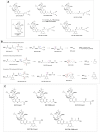Triglyceride-Mimetic Prodrugs of Buprenorphine Enhance Oral Bioavailability via Promotion of Lymphatic Transport
- PMID: 35496278
- PMCID: PMC9039622
- DOI: 10.3389/fphar.2022.879660
Triglyceride-Mimetic Prodrugs of Buprenorphine Enhance Oral Bioavailability via Promotion of Lymphatic Transport
Erratum in
-
Corrigendum: Triglyceride-mimetic prodrugs of buprenorphine enhance oral bioavailability via promotion of lymphatic transport.Front Pharmacol. 2022 Sep 5;13:1014363. doi: 10.3389/fphar.2022.1014363. eCollection 2022. Front Pharmacol. 2022. PMID: 36133812 Free PMC article.
Abstract
Buprenorphine (BUP) is a potent opioid analgesic that is widely used for severe pain management and opioid replacement therapy. The oral bioavailability of BUP, however, is significantly limited by first-pass metabolism. Previous studies have shown that triglyceride (TG) mimetic prodrugs of the steroid hormone testosterone circumvent first-pass metabolism by directing drug transport through the intestinal lymphatics, bypassing the liver. The current study expanded this prodrug strategy to BUP. Here different self-immolative (SI) linkers were evaluated to conjugate BUP to the 2 position of the TG backbone via the phenol group on BUP. The SI linkers were designed to promote drug release in plasma. Lipolysis of the prodrug in the intestinal tract was examined via incubation with simulated intestinal fluid (SIF), and potential for parent drug liberation in the systemic circulation was evaluated via incubation in rat plasma. Lymphatic transport and bioavailability studies were subsequently conducted in mesenteric lymph duct or carotid artery-cannulated rats, respectively. TG prodrug derivatives were efficiently transported into the lymphatics (up to 45% of the dose in anaesthetised rats, vs. less than 0.1% for BUP). Incorporation of the SI linkers facilitated BUP release from the prodrugs in the plasma and in concert with high lymphatic transport led to a marked enhancement in oral bioavailability (up to 22-fold) compared to BUP alone. These data suggest the potential to develop an orally bioavailable BUP product which may have advantages with respect to patient preference when compared to current sublingual, transdermal patch or parenteral formulations.
Keywords: buprenorphine; first-pass metabolism; lymphatic transport; opioid analgesics; oral bioavailability; prodrug; triglyceride mimetic.
Copyright © 2022 Quach, Hu, Han, Lim, Senyschyn, Yadav, Trevaksis, Simpson and Porter.
Conflict of interest statement
TQ, LH, SH, NT, JS, and CP are inventors of a lymph-directing glyceride prodrug technology that has been licensed to PureTech Health, Boston. TQ and JS are currently employed by PureTech Health. The remaining authors declare that the research was conducted in the absence of any commercial or financial relationships that could be construed as a potential conflict of interest.
Figures








References
-
- Abuse-Deterrent Opioids-Evaluation and Labeling (2015). Guidance for Industry Center for Drug Evaluation and Research. FDA. Available at: https://www.fda.gov/regulatory-information/search-fda-guidance-documents... .
LinkOut - more resources
Full Text Sources
Miscellaneous

